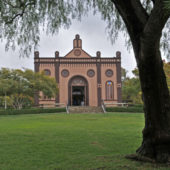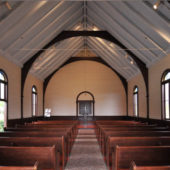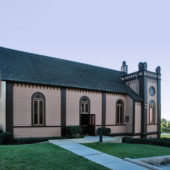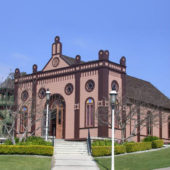Temple Beth Israel is the second oldest synagogue structure in the American West. It was built in the wake of the San Diego boom of 1886-1888. The building has been restored and relocated to Heritage Park in San Diego’s Oldtown district.
Temple Beth Israel, the second oldest synagogue building complex in the American West, was originally built in the wake of the San Diego boom, from 1886 to 1888. Between 1850 and 1888, Jews only arrived in the area in a trickle, but suddenly, they came in a flood. This was due to the railroad, which transformed San Diego into a bustling city. Jewish tradesmen and merchants moved to San Diego, seeking to take advantage of the new opportunities afforded. They opened clothing, book, stationery, ice cream, and grocery stores, as well as founded a bank and an opera house. The population in San Diego leapt from 2,637 in 1880 to 40,000 in early 1888.
September 25, 1889 was a significant day for the Jewish community, when they met at Second and Beech Street to greet the Jewish New Year of 5650 and pray in their own house of worship. During this time at Temple Beth Israel, there were approximately 300 congregants. The worshippers were thrilled. For years they had been meeting in homes, halls and Christian churches. They were so grateful to have a temple of their own in which to worship. Thirty-eight years before, there were only three Jews who worshipped together. Over the following six years, there were only a handful. In 1859, a minyan (a quorum of ten men required for a religious service) was obtained; and a room was set apart for services as a temporary synagogue. In 1861 San Diego founded a synagogue, the first in Southern California, Adath Yeshrun. In 1863 a severe drought struck the area, severely stifling business in Old Town and the synagogue dissolved.
With the advent of the railroad in the early 1870s, there were enough Jews once again to form a minyan. In 1871, fifty Jewish men, fourteen women and thirty-four children met together to form the First Hebrew Benevolent Society. Its purpose was to assist the needy and sick, and to bury the dead. Yet again, the boom collapsed in 1873 and the railroad dwindled. Only approximately fifteen Jewish men and their families remained in the city. In 1885, the completion of the California Southern Railroad connection to the east instigated a new real estate and building boom. Thus, Temple Beth Israel (House of Israel) was established with forty men on January 3, 1887. The congregation allied itself with the Reform Movement. Bids were received in mid-July of 1889 and construction commenced shortly thereafter. A school for religious instruction was also built. In 1886 to 1888 the area suffered an economic downturn, sliding into the Panic of 1893. Some local banks closed and many people lost their savings. This affected the synagogue: the religious school went downhill, Friday night services stopped, and the remaining eighteen or twenty families that remained were demoralized by the state of the economy. The Temple began renting the sanctuary to the First Universalists, then the Christian Scientists, and then the First Church of Christian Scientists.
By 1900, the congregation comprised only about fourteen families. However, within five years the economy improved and more Jews moved into the area. In fact, so many moved into the area, seating them all became a problem. In 1921 the loft was expanded into a full balcony. The recreation structure, built by the Jewish Welfare Board for Jewish servicemen at Camp Kearney, was moved in 1920 to the front of the lot next door. It became a Jewish community center, where classes, meetings, and social events could be held. The Third and Laurel Site occupied an entire city block, comprising many buildings, as well as apartments. Quality rabbis were hired, who raised the intellectual level of the congregation and fostered a wide range of programs. These included Bible studies, women’s and youth groups, bringing a richer religious and social life to the congregation.
Additional property was purchased, fundraising began and a new temple was built and dedicated in 926. The community sold the Second and Beech property. It was sold and re-sold to several owners falling into a sad state of disrepair. However, on June 1, 1973 it was listed as San Diego Historic Site No. 82. The historic former temple was re-acquired by the congregation and the seven buildings moved to Heritage Park, its current location. Public and private funds for restoration made the undertaking possible, and it is now open to public as a museum.
The initial Beth Israel Temple (shown here), was erected by carpenters featuring a redwood exterior, similar to Christian churches; however, it had a unique square front façade. Twin tablets, inscribed with the Ten Commandments, sit at the pinnacle of the façade, and round windows with Star-of-David designs run across the front and sides of the exterior. The façade is painted light brown, with chocolate brown trim. Inside, are two anterooms, with steps up to an organ loft. Inside the prayer room, four wooden arched trusses supported a sky blue ceiling. The French gray side walls feature three arched windows with glass in yellow, blue and rose, and dark brown woodwork. At the front of the prayer room is the bimah, on a slightly raised platform red. On the bimah, against the wall is the carved dark wood Aron Kodesh, placed within a dark wood archway. The tivah (reader’s desk) is simply carved of dark wood and sits on the podium in front of the Aron Kodesh. The eternal light hangs above it. Simply carved wood benches fill the sanctuary.




